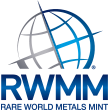Indium multi-ounce metal bar - .9999 bullion
Indium was discovered in 1863 by German scientists Ferdinand Reich and Hieronymous Richter while testing for thallium in ores from the mining town of Frieberg. Instead of finding the characteristic green emission line they sought, they found an unknown blue emission line in their spectroscopic samples. They determined it must be a new element and named it indium due to its indigo spectral signature. Indium is a rare metal. Given absence of significant deposits it is currently only produced as a byproduct of base metal mining, mostly from zinc tailings. Indium's mined production is currently about 40 times less than silver and estimated worldwide reserves of indium that can be recovered by economically viable means is 6000 tonnes. Approximately 18000 tonnes of silver and 2500 tonnes of gold are mined each year compared with about 670 tonnes of indium. It has been estimated that at current mining rates, worldwide resources of indium will depleted in 14 years. Based on this shortage and the boom of its consumption in the production of LCD TVs the price of one kilogram on indium skyrocketed from about $94 to $918 in the first decade of our new millennium.
Indium has unique physical properties including a very low melting point, a large liquid temperature range, is extremely soft and a has a relatively high density. It can also wet glass, has superconducting properties, is diamagnetic, is a powerful reducing agent, captures thermal neutrons efficiently and is nontoxic. Indium has a myriad of industrial uses, with about half of its consumption in the production of LCDs and touchscreens. It is also used in a wide range of alloys including the nontoxic mercury alternative alloy Galinstan which is liquid at room temperature, solders including glass seals, microelectronics, alkaline batteries, in superconducting systems, in nuclear control rods and in nuclear medicine imaging. Indium also has a promising new application as a component of quantum dot technology in double pane windows that could be used as luminescent solar power collectors, potentially turning our glass paned skyscrapers of the future into monstrous green energy powerhouses.
This batch of indium bars weigh between 450 and 550 grams (or about 14.5 to 17.7 troy ounces) each and are priced accordingly. They are all at least 99.99% pure. They have not been inscribed though will come with a copy of the assay certificate for this batch. These bars are nicely polished/finished similar to the group pictured from this same batch. Indium is a very soft metal. Thus, it is common to have small edge dings, surface scratches and impressions, and other minor imperfections that do not detract from the inherent value of this rare industrial metal, As always, weight and purity are guaranteed by Rare World Metals Mint. Indium in the solid form we supply is nontoxic. As we suggest with all of our metals please keep them in a safe place, do not ingest, and keep away from children.
Each indium bar will be shipped with an assay certificate and every shipment will include our velvet logo bag. If you are not completely satisfied with any purchase from us, you have 30 days to return it for a full refund (buyer to pay return shipping). Domestic shipping is free for all orders over $199 (enter code free shipping at checkout). For orders of $199 or under, domestic shipping is $9.95. International shipping is is via DHL, FedEx, or USPS international express and costs $45 for shipments up to a pound and $10 for each additional pound. International customers please be aware that your country may levy import duties and/or VAT taxes on your purchase from us. We have nothing to do with this and cannot pay it for you. If you refuse our package because of this extra cost we will take it back and will refund your order in full once received minus the cost of the return shipping. If you are unsure what these import costs will be please check with your country's customs office.
http://en.wikipedia.org/wiki/Indium
http://en.wikipedia.org/wiki/Abundance_of_elements_in_Earth%27s_crust
https://nora.nerc.ac.uk/id/eprint/513472/1/Risk_List_2015_FINAL.pdf
https://www.911metallurgist.com/blog/the-worlds-10-most-precious-metals










